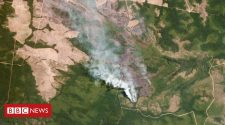The National Weather Service warned “a long duration and potentially . . . historic [wind] event” was expected to bring 85 mph gusts through the mountain regions of Northern and Central California between Saturday night and Monday morning with lesser, but still powerful, winds reaching valleys and coastal areas.
The ongoing wildfires come on the heels of the devastating 2017 and 2018 California fire seasons, which featured the largest, most destructive, and deadliest blazes on in state history. It’s part of a clear pattern toward larger, more frequent and destructive blazes, as well as a longer-lasting fire season. And, according to CalFire, “climate change is considered a key driver of this trend.” Population growth and the increase in homes and businesses located near lands that typically burn are also escalating the risk of and damage from wildfires in the Golden State.
Forecasters at the Weather Service say this wind event could bring the most explosive wildfire conditions since the 2017 wine country fires, which damaged much of the city of Santa Rosa and killed 22 people.
The strong winds in the forecast will pose a high risk of sparks, which would lead to potentially rapidly spreading wildfires, Pacific Gas & Electric said in a statement Friday. Approximately 850,000 customers, comprising millions of people across Northern and Central California, could be without power through the weekend as PG&E stood ready to cut power to the regions most at risk from the blaze.
The weekend outage would mark the second major shut-off spurred by PG&E this month. Power cuts from the gas and electric company about two weeks ago left nearly 2 million people without power at its apex.
Hundreds of miles south, the winds had changed more favorably for firefighters in Los Angeles County, where significant progress was made in halting the Tick Fire. Since Thursday, the blaze had consumed 4,300 acres and prompted as many as 50,000 people to evacuate after strong seasonal winds caused flames to race through the densely populated canyon region. Nine homes were destroyed.
The fire was 25 percent contained as of Saturday morning, and emergency crews were now focused on mitigating the hot spots left over from the line of flames and preventing embers from igniting new fires, said Capt. A.J. Lester of the Los Angeles County Fire Department.
By Saturday morning, an estimated 20,000-30,000 had been able to return to their homes, Lester said. Areas within the fire’s perimeter remained under evacuation orders, and over 1,300 firefighters remained on the scene. Two evacuation centers for fleeing residents had been established at nearby schools, as well as a separate location for animals.
Los Angeles County, as well as Sonoma County, have been under a state of emergency since Friday.
As Northern California prepares for a new onslaught from the Kincade Fire, PG&E is facing extreme scrutiny after reporting that though the utility said it cut power in Northern California on Wednesday, it had left stretches of high-voltage power transmission lines active in the region where the Sonoma County fire broke out. The same type of transmission line was responsible for the state’s deadliest wildfire ever — the Camp Fire in 2018.
At a Friday afternoon news conference, California Gov. Gavin Newsom (D) said there have been discussions about PG&E’s culpability, but they were not “conclusive.” The blame for the fire “is neither determined nor is that investigation complete,” he said, adding that he plans to hold the company accountable for “years and years of mismanagement.”
PG&E chief executive Bill Johnson said the company is conducting an internal investigation but has not accepted responsibility for the fire, adding that officials don’t know precisely how it started. “We still, at this point, do not know what exactly happened,” he said at a Thursday news conference.
The scene as a fast-moving wildfire ignites in Northern California wine country
In Santa Rosa, residents are only just rebuilding from the havoc wrought by the Tubbs Fire, which took lives and destroyed homes in 2017.
On Friday afternoon, a clear blue sky was broken by a gray plume that loomed over brown hills dotted with trees. Residents were on edge.
Natalie Pinzón, 45, who lives in Santa Rosa, lost her home two years ago. Five months after she moved into her newly rebuilt house, the Kincade fire brought those memories flooding back.
“It’s kind of sad the things that have been happening,” said Pinzón, who said there was little people could do — except to prepare the region’s power infrastructure for the future. “The thing is, we have to start doing something right now to make things better here.”
Terry Marshall said the nearby fire was alarming residents in her own Santa Rosa neighborhood. Their important documents were packed away in a suitcase in case they needed to flee.
“Certainly, it’s very frightening and it’s anxiety-producing for the community,” she said. “I know yesterday we were all very anxious at work.”
Marshall’s power has been shut down several times in the past few weeks, which she said has been scary and a source of anxiety. “At the same time,” she said, “I have an 11-year-old son and we play a lot of board games and do a lot of reading and try to make the best of it.”
Andrew Freedman, Brice-Saddler, and Epstein reported from Washington.














